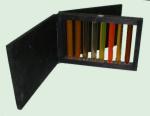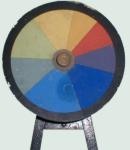 Menu
Menu
|
Function To study the dispersion of light. |

| ||
|
|||
|
Description From a rectangular wooden basis raise two columns that sustain an equilateral prism that can rotate on its axis. | |||
|
Function To study the angle of rotation of an optically active solution. |

| ||
|
|||
|
Description The light beam, generated by a monochromatic source (sodium light), crosses the Nicol prism (polarizer). The light that comes out is linearly polarized and half of it goes directly to the analyzing solution while the other half first crosses a half-wave plate. The two beams, with two different planes of polarization, are then analyzed by another Nicol prism. A circular vernier is placed on the eyepiece. By rotating the analyzer the intensity of the two beams changes. We have two angles where the two half zones are weakly or strongly illuminated, but with the same intensity. | |||
|
Function To study the fluorescence. |

| ||
|
|||
|
Description On a rectangular wooden frame we have eight glass tubes which hold fluorescent liquids. The ensemble is completed by two wooden planes hinged on the frame. They are used to protect the tubes. If the liquids are exposed to the light, they give radiations of different colours with very beautiful effects. | |||
|
Function To show that white light can be obtained as the sum of the rainbow colours. |

| ||
|
|||
|
Description The disk is formed of various sectors painted with the rainbow colours. It is used with the rotating machine. Because of the persistence of the image on the retina, the various colours superimpose giving the sensation of the white. | |||
|
Function To show the electric conduction in rarefied gases. |

| ||
|
|||
|
Description The beam of the cathode rays comes into the central side of the tube through a slit. It is made visible by an oblique fluorescent screen when iy goes near it. | |||